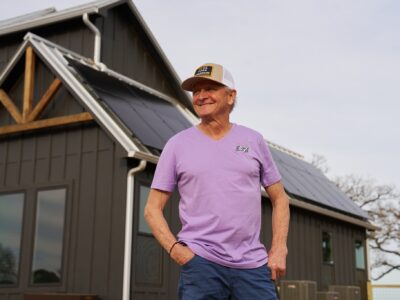(Bloomberg) —
When it was completed in 2012 for the Summer Olympics, Lydia Yuzva’s housing complex in East London was hailed as a beacon of green design and energy efficiency. The 2,800 units, a mix of apartments and town houses, have floor-to-ceiling windows, lots of insulation, and environmentally friendly heating systems that use waste heat from a nearby power plant fueled with biomass and gas. They were designed for the U.K.’s cold winters, trapping heat to reduce energy bills.
But what the designers of Queen Elizabeth Olympic Park didn’t consider was the steadily rising average temperature. All 10 of the U.K.’s hottest years since record keeping began in 1882 have occurred in the last 18 years, according to the U.K.’s Met Office. Yuzva’s apartment lacks air conditioning, and it’s become unbearably hot during the summer months. When she gave birth four years ago to a daughter with severe jaundice, she faced a dilemma: keep the curtains open to allow sun to reach the baby’s skin and help clear the condition more quickly or close them to keep the apartment cooler. On some of the hottest days, she says, she couldn’t even be in the flat with her baby. “For us it’s terrible to be too hot, but for a child it’s dangerous.”
Housing in northern European countries including the U.K. and Germany has long been built with one purpose in mind: keep people warm in the winter. Air conditioning was almost never included because the summers were temperate. But climate change has upended that calculus.
Already in the U.K., a fifth of all homes are said to overheat in the summer, meaning indoor temperatures exceed 28C (82F) more than 1% of the time the space is occupied, or 26C in bedrooms. With people stuck at home because of Covid-19 containment orders, many more residents will fall into the category. Since the Olympics, London’s high temperatures have averaged 23.3C, a jump from 21.6C in the years from 1961 through 1990. By the 2050s, according to government projections, London could be experiencing heat waves every summer, with temperatures exceeding 28C for three or more consecutive days.
Overheating can have profound effects on health and well-being and is particularly dangerous for vulnerable groups such as babies and the elderly. Extremely high temperatures can cause heatstroke, organ failure, and sometimes death. Even for healthy people it can cause sleep deprivation, which in turn can lead to sluggishness and accidents. As much as 3% of a country’s gross domestic product is lost because of lack of sleep, according to research organization Rand Corp.
The hot-house problem is partly an unintended consequence of tougher energy-efficiency building requirements. After the 1970s oil crisis, homebuilders started focusing more on making them airtight, sealing them up to stop heat from escaping to reduce consumption of heating oil in cold weather. That meant retrofitting old buildings and stuffing lots of insulation into new ones.
But as temperatures increased, experts understood that sealing buildings comes with a downside—reduced airflow. It’s a particular problem in cities, where newer buildings tend to have fixed, sealed windows. Also, the concrete outside absorbs heat throughout the day and radiates it at night, a phenomenon known as the urban heat island effect. “Insulation without changing the ventilation can bring some disastrous effects,” says Dame Julia King, deputy chair of the U.K. Committee on Climate Change.
Other heat research blames poor design, often motivated by cost considerations. The size of dwellings is also shrinking, yet they’re occupied by the same number of people and more appliances emitting heat. The arrival of air conditioning didn’t help, either. Architects and designers no longer had to think hard about traditional cooling techniques such as cross ventilation, says Illya Azaroff, who specializes in disaster planning for the American Institute of Architects. And now, he adds, we’re paying the price, because even air conditioning is becoming inadequate for temperatures. “We’ve now started to come full circle,” Azaroff says. “We realize we can’t build those boxes anymore that rely purely on air conditioning, because of climate change.”
What’s most frustrating for green building experts is that overheating can be ameliorated through relatively simple tweaks in the early design stage. One key is to ensure that apartments have windows on opposite sides, allowing the breeze to flow through. Yet modern apartments often have windows only on one side, making it difficult to generate a through-draft. Of course, that’s if the window can even open.
Better ventilation systems that can provide adequate fresh air are also important. Those systems might circulate new air into a room more frequently, say eight times an hour rather than once, as is typical now, according to bio Simon Wyatt, a sustainability partner at consultant Cundall Johnston & Partners LLP.
More efficient materials can have a big impact, too. Because of cost considerations, apartments are frequently built using lightweight materials that have a lower thermal mass, meaning they can’t absorb heat in the day and release it at night, says Masoud Tabatabaei, a building performance specialist with Monodraught Ltd., a low-energy ventilation company. Alnatura, a design sustainability lab in Darmstadt, Germany, developed walls made of loam, a kind of sandy clay, that have an evaporative cooling effect that prevents heat pockets from forming.
Many other improvements can be made by any homeowner. These include using ceiling fans; attaching shutters, balconies, and shading to the outside of a building; or planting trees to shield windows. Other changes are more expensive, such as redesigning layouts for better ventilation or adding additional external vents. What’s required varies from home to home, but regardless, the principles are easy to grasp. “The entire problem with this issue is it’s all very simple stuff,” Wyatt says. “It’s always amazing to see the lack of common sense that has gone into the build or design.”
While the fixes may be simple, only a few developers incorporate them in their designs. London Mayor Sadiq Khan has proposed a plan that requires building developers to carry out overheating modeling against extreme weather scenarios. It says air conditioning should be a last resort, with developers prioritizing building design and passive ventilation.
The U.K. as a whole is considering similar rules, but those would apply only to new construction, unlike London’s. Some 80% of the buildings people will be living in by 2050 are already built, according to Khan’s office.
It may be left to the courts to push reforms. Wyatt says he’s increasingly hired by developers worried that overheating issues will turn into litigation. At a new building in central London, he says, contractors were forced to replace at their own cost fixed windows with ones that can be opened after indoor temperatures reached 35C in the summer of 2018. In another situation that summer, a developer was stuck with uninhabitable rental units because they hit 40C, so the contractor needed to foot the bill for each £300 ($400) per-week room.
Those cases say a lot about the trend of climate change. “This kind of work didn’t exist a few years ago,” Wyatt says.
Meanwhile, Yuzva decided to move out of Olympic Park, in part because of the heat. It’s a relief to be in a more temperate property outside of the city, she says. “The last week, during those hot days, I felt my heart was going to jump out. I just couldn’t wait to go out. I felt I couldn’t breathe.”
To contact the author of this story:
Jess Shankleman in London at jshankleman@bloomberg.net
© 2021 Bloomberg L.P.





